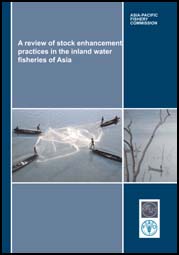|
De Silva, S.S. and Funge-Smith, S.J. 2005. A review of
stock enhancement practices in the inland water fisheries of Asia. Asia-Pacific
Fishery Commission, Bangkok, Thailand. RAP Publication No. 2005/12, 93
p.
ABSTRACT
Inland fisheries contribute only about ten percent to global
fish production. Asia is the leading producer of inland fish, accounting for
over 80 percent of the total production. Until recently, the inland fisheries
sector had taken back stage in fisheries development plans, particularly so,
given the emphasis being placed on aquaculture development throughout the world,
including Asia. This report evaluates the inland fishery practices in a number
of Asian countries according to habitat type, role in overall food fish supplies
and development trends. Special emphasis is laid on stock enhancement in inland
fisheries in Asia, and only those fisheries in which some form of stock
enhancement is practised are considered in this report.
In Asia, inland fisheries are mostly rural, artisanal
activities catering to rural populations and providing an affordable source of
animal protein, employment and household income. Stock enhancement is an
integral component of many inland fisheries. With recent developments in
artificial propagation techniques for fast-growing and desirable fish species
and the consequent increased availability of seed stock, such activities are
beginning to affect inland fishery production in most Asian countries. Indeed,
new avenues of production such as culture-based fisheries are increasingly
adopted and seen as a way forward in most countries. Inland fishery activities
also have a distinct advantage in that their development is usually less
resource intensive than is aquaculture.
The economic viability of stock enhancement of large
lacustrine waterbodies and rivers has not been demonstrated in any of the Asian
countries, the fisheries of such waterbodies being dependent on naturally
recruited stocks. The most successful stock enhancements in Asia are in
floodplain beels and oxbow lakes in Bangladesh where the use of small
waterbodies that are not capable of supporting natural fisheries has led to
culture-based fisheries having stock and recapture rates that are very high.
Culture-based fisheries are not resource intensive and are community-based
activities. However, their success requires major institutional changes, and
these are affected by national and local governments. In general, they can be
considered to have the greatest potential for further development.
A major concern related to stock enhancements in inland waters
is their possible effects on biodiversity. This is for two reasons: firstly,
most countries depend wholly or partially on exotic species for stock
enhancement and secondly, freshwater fishes are known to be among the most
threatened of vertebrates. Major studies should be undertaken to evaluate the
current situation so that remedial steps can be taken, if needed, without
causing serious harm to some of the stock enhancement practices that are gaining
momentum. |
